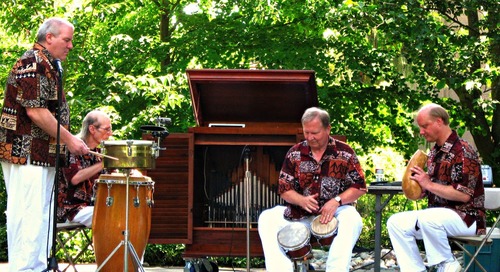Música Molida
La Música Molida
Travelers to eastern Cuba are frequently surprised to run into large mechanical organs with full percussion orchestras playing on the streets, in hotels and at community events. This seems an odd juxtaposition of old Europe and Africa? Even the best informed of Cuban musicians knows little about this perennial favorite; its roots, operation and traditions. For that reason, we've put together this page to help inform latin music lovers about Órgano Oriental. We hope you enjoy "Música Molida" as much as we do. Mechanical organs first appeared in Cuba in 1876, at which time, the Fornaris and Borbolla families from eastern Cuba (Manzanillo) acquired mechanical organs built by Limonaire of Paris. Because of their origins, these organs are referred to as "órgano oriental", i.e. the organ from eastern Cuba. At an even earlier period, the mechanical organ was also introduced by the French to Haiti.
During the period surrounding the Haitian revolution, Haitian refugees brought many musical genres from Haiti and developed them further in Cuba. The Tumba Francesca, Charangas Francesas, Regla de Arará and Órgano Oriental all owe their presence in Cuba to this period in Haiti’s history. Cuban organs were originally built to play waltzes, mazurkas and polkas. They were the early Barbieri inspired “barrel organs” that work much like large music boxes. These organs were soon combined with Afro-Cuban percussionists, performing live with the órgano to form a uniquely Cuban conjunto. The result was a cost effective orchestra, which was fully functional in street and festival venues.
The early barrel organs gave way to the new book styled organs and the European musical repertoire was slowly replaced by contemporary Cuban songs; sons, danzónes, rumbas, cha cha chas, merengues and mambos. The whole musical effect is called 'música molida' or ‘ground music’, and is still very popular, especially in eastern Cuba. Unlike most European street organs, Cuban organs are finely made wooden boxes. Without gaudy ornaments on the façade and beautiful in their simplicity, their sound resembles the French organs built by Gasparini and Limonaire. Another difference, is the absence of automatic percussion as used in Europe and North America. Mechanical percussion is useless in such a sophisticated percussion culture as Cuba's. As such, the organ is part of a larger orchestra, which includes congas, bongó, timbales, claves, maracas and güiro.
Since 2009, we have been using 2 organs to play Cuban and Brazilian music here in Seattle; Órgano Sabiá and Órgano Maria Bonita. Órgano Sabiá is a 2 1/2 octave - diatonic - 20 note crank organ and Órgano Maria Bonita is a 5 octave - chromatic - 96 note crank organ. All of the music arrangements were written by Gary Harding and are set in MIDI format. Both organs are hand blown. With these organs we use a full traditional percussion section to play many of Latin America's most popular dance idioms, including the music of Brazil [forró, samba, chorinho etc] which most Cuban órganos are unprepared to play. The money earned with these ensembles supports 4 children in the developing world through World Vision. Please see our page on World Vision and our efforts through this organization.
Please take a listen to our Órgano Oriental playlist posted above.
Ethnic Playlists: http://tinyurl.com/le5fjes
KEYWORDS: Realejo, Organillo, Organito, Organo Oriental, Organetto de Barberia, Orgue de Barbarie, Orgue de foire, Drehorgel, Draaiorgel, Pierement, Straatorgel, Lirekasse, Positiv, Crank Organ, Street Organ, Monkey Organ, Barrel Organ, Fair Organ, Dance Organ - The least known and one of the most beautiful of all Cuban musics: "La Música Molida" ..... Bartolomé Masó, Bayamo, Buey Arriba, Campechuela, Cauto Cristo, Guisa, Jiguaní, Manzanillo, Media Luna, Niquero, Pilón, Río Cauto, Yara, Baracoa, Caimanera, El Salvador, Guantánamo, Imías, Maisí, Manuel Tames, Niceto Pérez, San Antonio del Sur, Yateras, Antilla, Báguanos, Banes, Guardalavaca, Cacocum, Calixto Garcia, Cueto, Frank País, Gibara, Holguín, Niquero, Mayarí, Moa, Rafael Freyre, Sagua de Tánamo, Urbano Noris, Amancio, Colombia, Jesús Menéndez, Jobabo, Las Tunas, Majibacoa, Manatí, Puerto Padre, Contramaestre, Guamá, Mella, Palma Soriano, San Luis, Santiago de Cuba, Segundo Frente, Songo-La Maya, Tercer Frente
